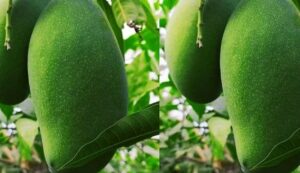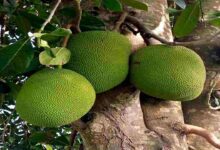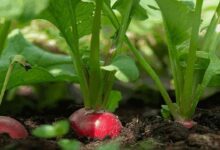Stem borer insect is very dangerous for mango production, know its identification and prevention
Mango Cultivation: A major issue in mango production is stem borer. By creating holes in the stems and branches, this bug harms the trees from the inside out, halting their development and lowering their potential for output. Batocera rufomaculata is the stem borer’s scientific name. Effective control requires a comprehensive strategy that incorporates mechanical, chemical, and biological techniques.

The pest’s life cycle and identification
Management of stem borer requires an understanding of its life cycle.
- Egg: The female bug deposits its eggs in the stem’s bark or crevices.
- Larva: The larva enters the stem, forms a tunnel, and feeds there after emerging from the egg.
- Cocoon and adult: After creating a cocoon, the larva develops into an adult insect.
- The wood sawdust and sap leaking that the stem borer leaves behind are indicators of its presence.
Management Actions
1. Preventive Actions
To manage stem borer, the following actions may be taken, including…
- Plant selection: Choose pest-free, healthy plants from the nursery.
- Agrotechnical Practices: To preserve air movement around the trees, place them at the right distance apart.
- Sanitation: Clear the orchard of trash, dried branches, and fallen leaves.
- Bark Inspection: Examine tree cracks on a regular basis.
2. Mechanical Actions
- Pruning of afflicted areas: Trim and burn the pest-infested stems and branches.
- Cleaning of holes: Use fine wood or iron wire to clear the insect tunnels.
- Hole closure: Use lime paste, clay, or wax to seal the holes.
3. The Management of Biology
- Biological pest control is sustainable and safe for the environment.
- Utilization of parasitoids and wasps: Apply bio-control agents, such as Trichogramma or braconid wasps, to stem borer eggs and larvae.
- Products made from neem: neem cake or neem oil spray.
- Installing pheromone traps will draw in adult insects.
4. Management of chemicals
- In situations of severe infestation, chemical measures may be used.
- Use Dichlorvos 76 EC or Chlorpyrifos 20 EC for handling contact pesticides.
How contact insecticides are used
- Apply 5–10 ml of pesticide to the holes that are impacted. Use dirt, lime, or wax to seal the hole.
- Natural chemicals: To encourage organic farming, use biopesticides such as Bacillus thuringiensis (Bt).
5. Cultural Actions
- Tree maintenance should include periodic pruning.
- Management of nutrients: Make balanced use of fertilizers and biofertilizers.
- Management of irrigation: Steer clear of waterlogging, which may erode tree roots and stems.
Advantages of controlling stem borer
- The ability of trees to grow and produce is preserved.
- Agriculture is certain to be sustainable for the long run.
- Chemicals are not used excessively.
In brief
A comprehensive strategy that incorporates chemical treatments, mechanical techniques, biological control, and preventative measures may be used to manage mango stem borer pests. Stem borers must be managed with regular monitoring, knowledge of the pest’s life cycle, and prompt action when necessary. Together with this, it’s critical to educate and teach farmers so they can successfully defend their orchards against stem borer.

